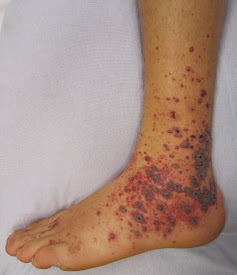MCQ on Pathology of Vascular System
1) Vasculitis is a term referred to a vessel wall inflammation.
Which of the following is the mechanism of non-infectious vasculitis?
a) Immune complex deposition
b) Antineutrophilic cytoplasmic antibodies
c) Autoreactive cells
d) All of the above
2) Based on the location, vasculitis may be classified into large, medium, and small-vessel vasculitis.
Identify the disease associated with large vessel vasculitis.
b) Antineutrophilic cytoplasmic antibodies
c) Autoreactive cells
d) All of the above
2) Based on the location, vasculitis may be classified into large, medium, and small-vessel vasculitis.
Identify the disease associated with large vessel vasculitis.
a) Kawasaki disease
b) Takayasu arteritis
c) Wergener granulomatosis
d) Chrug Strauss Syndrome
3) Identify the disease associated with small vessel vasculitis
a) Kawasaki disease
b) Takayasu arteritis
c) Wergener granulomatosis
d) Chrug Strauss Syndrome
4) Identify the condition associated with medium vessel vasculitis:
b) Takayasu arteritis
c) Wergener granulomatosis
d) Chrug Strauss Syndrome
3) Identify the disease associated with small vessel vasculitis
a) Kawasaki disease
b) Takayasu arteritis
c) Wergener granulomatosis
d) Chrug Strauss Syndrome
4) Identify the condition associated with medium vessel vasculitis:
a) Kawasaki disease
b) Takayasu arteritis
c) Wergener granulomatosis
d) Chrug Strauss Syndrome
5) Chrug-Strauss Syndrome is characterized by a small vessel necrotizing vasculitis associated with asthma, allergic rhinitis, lungs infiltrate, peripheral hypereosinophilia, and extravascular necrotizing granulomata.
Identify the true statement regarding Chrug-Strauss Syndrome:
a) Anti-neutrophil cytoplasmic antibodies are undetectable
b) Myocardial involvement and cardiomyocytes are often associated with the presence of eosinophilic infiltrates
c) Vascular lesions is accompanied by granulomas and eosinophils
d) Patients are hyper-responsive to allergic stimuli.
6) 'Behcet's disease'/ 'Behcet's syndrome' is a small to medium 'neutrophilic vasculitis' which may be presented as........................................................
a) Clinical triad of asthma, allergic rhinitis, and Hypereosinophilic syndrome
b) Exaggerated vasoconstriction of arteries and arterioles in the extremities
c) Clinical triad of recurrent oral aphthous ulcer, genital ulcer, and uveitis
d) All of the above
7) Identify the infectious agent that can trigger vasculitis. Select all the correct answers
b) Takayasu arteritis
c) Wergener granulomatosis
d) Chrug Strauss Syndrome
5) Chrug-Strauss Syndrome is characterized by a small vessel necrotizing vasculitis associated with asthma, allergic rhinitis, lungs infiltrate, peripheral hypereosinophilia, and extravascular necrotizing granulomata.
Identify the true statement regarding Chrug-Strauss Syndrome:
a) Anti-neutrophil cytoplasmic antibodies are undetectable
b) Myocardial involvement and cardiomyocytes are often associated with the presence of eosinophilic infiltrates
c) Vascular lesions is accompanied by granulomas and eosinophils
d) Patients are hyper-responsive to allergic stimuli.
6) 'Behcet's disease'/ 'Behcet's syndrome' is a small to medium 'neutrophilic vasculitis' which may be presented as........................................................
a) Clinical triad of asthma, allergic rhinitis, and Hypereosinophilic syndrome
b) Exaggerated vasoconstriction of arteries and arterioles in the extremities
c) Clinical triad of recurrent oral aphthous ulcer, genital ulcer, and uveitis
d) All of the above
7) Identify the infectious agent that can trigger vasculitis. Select all the correct answers
a) Pseudomonas spp
b) Aspergillus spp
c) Mucor spp
d) Salmonella spp
8) The anti-neutrophil cytoplasmic antibodies are usually negative in which of the following condition of vasculitis?
b) Aspergillus spp
c) Mucor spp
d) Salmonella spp
8) The anti-neutrophil cytoplasmic antibodies are usually negative in which of the following condition of vasculitis?
a) Microscopic Polyangiitis (MPA)
b) Eosinophilic Granulomatosis with Polyangiitis (EGPA)
c) Polyarteritis Nodosa (PAN)
d) Granulomatosis with Polyangiitis (GPA)
9) Atherosclerosis is the major underlying cause of coronary, cerebral, and peripheral vascular disease. The likelihood of atherosclerosis is determined by both genetic and acquired predisposing factors. Identify the genetic cause of atherosclerosis
b) Eosinophilic Granulomatosis with Polyangiitis (EGPA)
c) Polyarteritis Nodosa (PAN)
d) Granulomatosis with Polyangiitis (GPA)
9) Atherosclerosis is the major underlying cause of coronary, cerebral, and peripheral vascular disease. The likelihood of atherosclerosis is determined by both genetic and acquired predisposing factors. Identify the genetic cause of atherosclerosis
a) Hypertension
b) LDL receptor mutation
c) High Cholesterol
d) Smoking
10) Framingham Heart study of the United states of America has identified various risk factors associated with atherosclerosis. These risk factors may be broadly classified into non-modifiable and modifiable factors.
b) LDL receptor mutation
c) High Cholesterol
d) Smoking
10) Framingham Heart study of the United states of America has identified various risk factors associated with atherosclerosis. These risk factors may be broadly classified into non-modifiable and modifiable factors.
a) Hyperlipidemia
b) Diabetes
c) Hypertension
d) Family History
ii) Identify the modifiable risk factor of atherosclerosis:
a) Genetic abnormalities
b) Hyperlipidemia
c) Diabetes
d) Hypertension
Answers:
1-d) All of the above
2- b) Takayasu arteritis
3- Option b) & c)
4-a) Kawasaki disease
5- Option b), c) & d)
6- c) Clinical triad of recurrent oral aphthous ulcer, genital ulcer, and uveitis
7- a), b) & c)
8- c) Polyarteritis Nodosa (PAN)
9- b) LDL receptor mutation
10 i- d) Family History
10 ii- b) Hyperlipidemia
a) Genetic abnormalities
b) Hyperlipidemia
c) Diabetes
d) Hypertension
Answers:
1-d) All of the above
2- b) Takayasu arteritis
3- Option b) & c)
4-a) Kawasaki disease
5- Option b), c) & d)
6- c) Clinical triad of recurrent oral aphthous ulcer, genital ulcer, and uveitis
7- a), b) & c)
8- c) Polyarteritis Nodosa (PAN)
9- b) LDL receptor mutation
10 i- d) Family History
10 ii- b) Hyperlipidemia

Comments
Post a Comment